FAQs on Parrot, Jelly-Bean... Cichlids, Genetic Disease
FAQs on Parrot Disease:
Parrot Cichlid Health 1,
Parrot Cichlid Disease 2,
Parrot Cichlid Disease 3,
Parrot Cichlid Disease 4,
FAQs on Parrot Cichlid Disease by Category:
Diagnosis,
Environmental,
Nutritional (e.g. HLLE),
Social,
Infectious (Virus,
Bacterial, Fungal), Parasitic (Ich, Velvet...),
Treatments,
Related Articles:
Blood Parrots & Flowerhorn Cichlids: maintenance and healthcare of two popular hybrid
cichlids by Neale Monks,
Neotropical Cichlids,
African Cichlids,
Dwarf South American Cichlids,
Cichlid Fishes in General,
Related FAQs:
Parrot Cichlids 1, Parrot Cichlids 2,
Parrot
Cichlid Identification,
Parrot Cichlid
Behavior, Parrot Cichlid
Compatibility, Parrot Cichlid
Selection, Parrot Cichlid
Systems, Parrot Cichlid
Feeding, Parrot Cichlid
Reproduction,
|
Troubles swimming, eating, staying upright...
|
|
Parrot fish gill issue? 9/13/18
Hello,
I hope you can forgive me.
<Certainly>
I’m not to tech savvy with forums. I need help. I have a parrot fish
that has some sort of red worm looking things in her gills.
<Mmm; all I can see are the fish's gill lamellae, the outside gill
filaments... No worms in evidence>
I’ve had two parrots years ago. I don’t remember them having gills like
this one. She was given to me by a neighbor that had to move.
<Ahh!>
I don’t know her history. She seems pale but healthy ,sassy and fun. I’d
like to her help if this gill issue is not normal.
Thank you so very much,
Sonya
<Thank you for sharing your concern w/ us. This sort of "genetic
abnormality" is quite common w/ Parrot Cichlids; a hallmark of too much
inbreeding of this hybrid mutant. There is nothing to be done in the way
of treatment here, and the fish may well live a good long while. There
can be a concern w/ having too-aggressive tankmates nipping at the
exposed gill membrane, but otherwise I would not be worried.
Bob Fenner>
|
 |
|
Re: Parrot fish gill issue? 9/13/18
Bob,
Thank you so much!
<Welcome Sonya>
I’ll just let her enjoy life. She’s pretty much left to herself. So
hopefully no nip‘ will take place. Thank you for these tips and the fast
response.
<Ah, anima bona fac; be of good life>
Sincerely,
Sonya
<Cheers, BobF>
|
|
Not sure if my hybrid BP is sick :( 2/9/16
/RMF
Hello I have read like every section of WWM and I'm convinced its the best site
out there to help people with their aquatic pets,(I'm a big fan), would also
like to donate to the site as it has helped me a lot!
<Appreciated>
I'd be great full on info on how to do that but most importantly my Blood Parrot
Cichlid has umm developed a bit of raised scales on his body but does not have a
big belly/abdomen (I was thinking (from research on your site maybe dropsy?)
<Perhaps. Raised scales can occur from other causes... aspects of (poor) water
quality like high Nitrate, physical damage...>
but is eating and pooping fine I think (his house/cave always has poop in there)
and most important for you to know is I have had him for about 6 weeks give or
take a few days-his tank is a 90 gal with a double bio wheel waterfall filter
and a 125gal HOB aqua clear filter with a power head for surface movement and
fun for my wet pets too, as well as 2 bubble bars
-he is 5-6 inches long from nose to tail,(when he was introduced about 5-6 weeks
ago the tank had been cycled for about 6 months
-tank mates are 4 clown loaches
<Oh! Quite sensitive to dire and change-able water chemistry...>
(2 inches each and will be going to a bigger tank shortly as they are rescues) a
6 inch sailfin Pleco and a 2.3-3inch little blood parrot (who has the sweetest
personality) he still is grey with black stripes but is so parrot (can't close
his triangle mouth and his beak head)
-we do 15% water changes twice weekly on all our tanks(I'm a stickler for water
cleanliness) -ammonia 0, nitrites 0 ,nitrates 10 ,and PH 7.4 I'd like to send a
pic or video, I'm on my iPhone ,how can I do that for you and please let me know
if you need any more info, thank you and you have no idea the difference your
all making.
Sara Sidwell
<Well; your water seems fine... I suspect that trauma of some sort is at play
here; likely a "bump in the night" with some object. I would do nothing
treatment-wise at this point, but remain vigilant in observing this hybrid
cichlid. Should other symptoms appear, please take a well-resolved (still) image
and re-write us. Bob Fenner>
Not sure if my hybrid BP is sick :( /Neale
2/11/16
Hello I have read like every section of WWM and I'm convinced its the best site
out there to help people with their aquatic pets,(I'm a big fan), would also
like to donate to the site as it has helped me a lot!
<Thanks for the kind words.>
I'd be great full on info on how to do that but most importantly my Blood Parrot
Cichlid has umm developed a bit of raised scales on his body but does not have a
big belly/abdomen (I was thinking (from research on your site maybe dropsy?) but
is eating and pooping fine I think (his house/cave always has poop in there) and
most important for you to know is I have had him for about 6 weeks give or take
a few days
<Important indeed!>
-his tank is a 90 gal with a double bio wheel waterfall filter and a 125gal HOB
aqua clear filter with a power head for surface movement and fun for my wet pets
too, as well as 2 bubble bars -he is 5-6 inches long from nose to tail,(when he
was introduced about 5-6 weeks ago the tank had been cycled for about 6 months
-tank mates are 4 clown loaches (2 inches each and will be going to a bigger
tank shortly as they are rescues) a 6 inch sailfin Pleco
<Not good companions for cichlids that can't look after themselves... such as
deformed fish like Blood Parrots. The problem is Plecs are boisterous and
greedy, plus they have a tendency to "latch" onto weak fish to graze at the
mucous. Because this happens at night, it's easy to miss except for the fact the
cichlid is stressed and has damage on the flanks, such as missing
scales or red blisters. Isolating the Plec may help turn things around.>
and a 2.3-3inch little blood parrot (who has the sweetest personality) he still
is grey with black stripes but is so parrot (can't close his triangle
mouth and his beak head)
<Hmm... odd deformity, but provided he can feed, not lethal.>
-we do 15% water changes twice weekly on all our tanks(I'm a stickler for water
cleanliness) -ammonia 0, nitrites 0 ,nitrates 10 ,and PH 7.4 I'd like to send a
pic or video, I'm on my iPhone ,how can I do that for you and please let me know
if you need any more info, thank you and you have no idea the difference your
all making.
Sara
<I would have you do some reading first:
http://www.wetwebmedia.com/fwsubwebindex/SaltUseFWArtNeale.htm
How to use Epsom salt, which I'd do right now if you suspect slight bloating;
also here:
http://www.wetwebmedia.com/fwsubwebindex/dropsyfaqs.htm
If things get worse; and finally, here:
http://www.wetwebmedia.com/metranidazole.htm
This medication is a very useful treatment for all manner of mysterious cichlid
ailments. Cheers, Neale.>
|
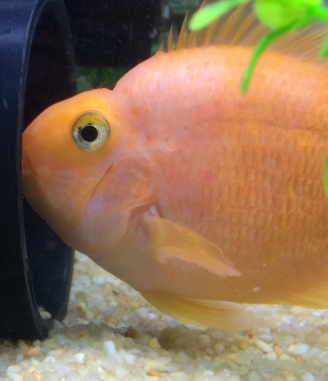
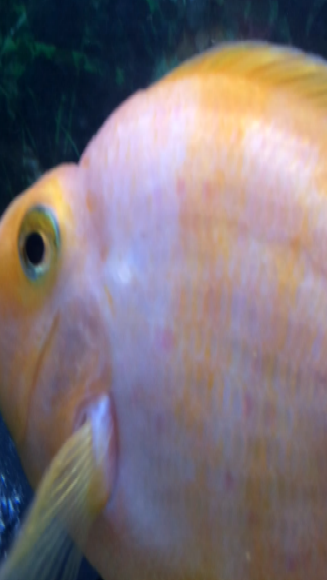 |
Aged blood parrot cichlid, abscess
recurring 7/26/13
Hi crew,
<Brian>
I've written before about my 14 year old blood parrot cichlid who had slowly
lost much of her fins and too many scales at the base of her fins, but I'm
hoping for some advice again.
A couple months ago she developed an abscess on her head just above an eye.
It started as a dark patch, then grew to a bulge and then split or erupted
into a brownish, whitish lump with cauliflower sort of texture that
eventually flaked off. It healed over quickly, leaving a slightly pitted
area. Now she has another one forming in just about the same spot (photo
attached). Last time I treated the water with Metronidazole and Kanamycin as
it got close to bursting to try to avoid secondary infection, which seemed
to be successful (or unnecessary).
<Ahh>
I've tried giving her medicated food but she seems to despise the taste of
Metronidazole. I used a Repashy gel food mix, which she devours on its own,
but refuses when I have Metronidazole mixed in. Can you suggest any
alternative systemic medications that might be effective and not taste so
bad it will be refused?
<Mmm; no... I would not try to treat this condition directly. Not likely
worthwhile/effective; and much to be lost (nitrifying bacteria; impacts to
immune system, kidney/nephric damage) by exposure>
Other than keeping her water pristine for which I continue to do all I can
with water changes, can you offer any further tips?
<There are none as far as I'm aware. With fishes of this sort/make up
genetically, there is only so much "replicative error accumulation" that
individuals can/do resist... senescence/"old age" is likely the real arbiter
here>
Perhaps Epsom salts to try to draw out fluid?
<Perhaps a low dose... a level teaspoon per five gallons...>
Treat the water again with Kanamycin and Metronidazole, or something else,
or not at all?
<Not a fan of either antibiotics nor the Flagyl here... rationale gone over
and over on WWM>
I don't think we could starve her into eating the Metronidazole. Through it
all she has stayed active and does not appear to be in distress.
Thanks,
-Brian Pardy (Vermont)
<I would learn to tolerate the growths/abscesses as "marks of age". Bob
Fenner<> |
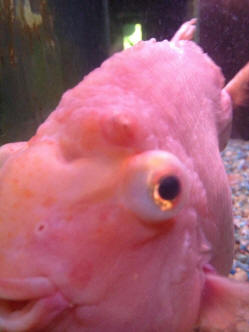 |
|
My blood parrot's gills have changed. --
11/08/11
<Where did you miss that we only accept image work in hundreds
of Kbytes?>
Hi, I have a 10 year old blood parrot and a year old Pleco in a
55 gallon tank with a Penguin 350 and a Penguin 200 power filter
both from Marineland with bio wheel. Over the past three weeks or
so, I noticed my blood parrot's gills changing. The edges
have become very thin and papery (I say for lack of a better
word.). They have also curled up some on the top and very bottom
and are very pale and grayish in color. I have checked everything
possible. The water quality and chemistry is all great; I'd
have a really angry fish otherwise. She always brings her
floating glass fish to the front of the aquarium when things
aren't right,
>?>
and she has one color fish for each issue.
<Time for an intervention?>
Still, though, once I noticed the changes, I checked everything
(pH, ammonia, nitrite, temperature) and all is normal. She seems
to have no concern about it; she stills eats and swims normally.
There is no change in her personality or actions; she's still
a little devil ;). I apologize for the pictures; it'll be
difficult if not impossible to see what I'm talking about
being as she did not want her picture taken. Luckily she loves to
sit in your hand, so I was able to get a few decent ones taken
that way. Also, as you may be able to see a little bit in the
second picture, all of her fins, except her pectorals, are
starting to kink or become wavy. Overall, she is healthy.
She's not visibly sick nor diseased.
<... either an anomaly in water quality... for which you
likely, there is no likely test for hobbyists... Or simple
genetics have unfolded to reveal this malformation. I'd be
doing the usual default sequential water changes, look about for
anything (new) that may be mal-affecting water make-up (and
removing it) the use of chemical filtrants (e.g. activated
carbon)...
Otherwise... ten years is a ripe old age for this mutant cross.
Bob Fenner>
|
|
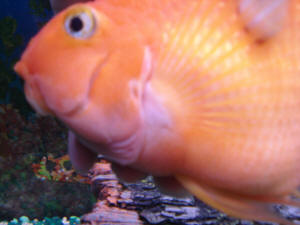
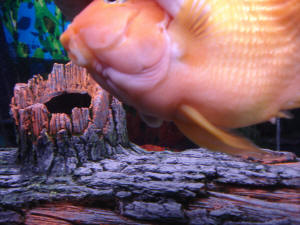
|
Re: My blood parrot's gills have
changed. -- 11/08/11
Well, I apologize; I did resize my pictures through Windows Live
Photo Gallery, but apparently it didn't take. And there is no
reason to be rude, I know she's old: I've taken very good
care of her for her to reach that age. Time for an intervention??
Really? The fish is smart; it may be odd and people may call me
crazy,
<Don't listen to them>
but it's what she does. You know I think it's really sorry
that you want to talk to someone like this who's just looking
for some help. I read the four forums on the website, looked
through dozens of links on Google, and thought I could get an
answer from you.
<You did>
And you want to talk about me? On several of the forums, there were
people who had no idea about anything. The crayfish killing the
fish, what's a nitrAte,
<NO3>
ten large fish in a small aquarium, etc., and not a single response
is as rude as you've been to me. Thanks for nothing.
<As welcome> |
Re: Urgent problem with Gourami
6/26/09
Thought you might be able to help me with a new problem!
First of all - that baby Gourami is still swimming about and the
abscess appears to have healed! I'm thrilled that
"Piglet" has made it - didn't take too long to get
attached to her/him!
<Cool.>
NOW THEN - my new problem is with our blood parrot
cichlid Paulie - I just went in to feed everyone and noticed
that Paulie has developed a lump on his head just above and between his
eyes - he looks like he's sprouting a horn or something! I've
become especially attached to our "parrot head" cichlids Paulie and Buffet - please help if you can.
<Blood Parrot cichlids are hybrids, and as such, they're much
less predictable that true species and much more prone to developmental
abnormalities, so things like simple deformities are a possibility.
Other
things to consider are physical damage caused by fighting, and a
disease called Hole-in-the-head. Blood Parrot cichlids are large,
territorial cichlids, and you'll have problems keeping two males in
a tank less than, say, 55 gallons, and if kept in a too-small tank they
may fight, and in the process damage themselves. Finrot is a bacterial
infection that sometimes sets in when fish are physically damaged, but
is more often caused by water quality problems. It looks like what it
is: patches of dead skin and blood.>
These are actually my son's fish which I "inherited" care
of when he went off to college. He's home now & just took care
of vacuuming and a water change in just the last couple of days. I
noticed the temperature is
slightly up but still within the "safe" range - no food
changes - not sure where the ph & alkaline levels are at.
<Can't really advise without knowing about the environment, and
a photo is essential when talking about lumps and bumps on fish. But
please, keep photos at less than 500 kb each.>
My son will look into this when he returns tomorrow - but I'm not
content to wait - I have to be sure Paulie will be ok!
Thanks for your time & expertise.
Jen
<Cheers, Neale.>
Parrot Cichlid With Swim Bladder Problem 9/9/08
Good day! I was checking the site to look for similar problem as my
parrot fish, Some are same but no mention of the weird way of drop
landing and staying on the ground nesting-like attitude. About 5 years
ago my friend gave me a blood parrot, because he has this heart shape
tail and its really cute. At first I thought it would be extra burden
to care for fish because I don't know much about them compared to
dogs where in I have 4. So far over the years he was alright, but last
June he got really sick. I could tell because he has this while cotton
like around his fins and he doesn't swim much. He stays on the
ground, doesn't eat and struggles to swim up to the surface just to
catch some air. H also swims upside down, also probably common to
parrot fish when they really sick. So I got really worried, went to a
pet store and bought this SERA BAKTOPUR. I changed the water and
treated it with the Baktopur, after 2 days I changed the water again
then treated it. I stopped the treatment as per instructed by the box
label then two days after I just changed it to clean water. He was
alright after a month, he was back again! He plays with me. Again when
I stick the food to my finger he would slightly surface up to get it on
my finger tip. So that's his past. Just recently, like 4 days ago,
I noticed that he stays on the ground a lot, he swimming is funny
because he just swims around for a second then drops to the ground like
he couldn't do a perfect landing. This is really really weird. He
eats fine, still plays with my finger when I'm feeding him. If I
pass by the aquarium he recognized me though and swims to the corner,
so other than the swimming problem and the bad ground landing he is
fine. I just want to treat it before it gets worse or progress to more
scary disease. Please HELP
ps: Can I still use the Sera Baktopur to treat my parrot fish? The
label says water treatment against mouth and fin rot and bacterial
infections in freshwater aquariums. Symptoms of bacterial disease are
white to grayish spots, blood spots and sores on the skin, also
infections on and around the fish anus and on the edges of the fins.
Dropsy, recognizable by the protruding of scales, a bloated body and
bulging eyes. a cotton wool like fluff around the mouth, White-gray
nodules on the head and fins and an agitated swimming motion at the
bottom of the aquarium. White edges of the fins and sometimes complete
destruction of the fins.
Direction: 1st day: 22 drops or 1 ml per each 20 liters
2nd day no treatment
3rd day 22 drops or 1 ml per each 20 liters
Composition:
100 ml sera Baktopur contain,,,
Acriflavine 209.7 mg
Methylene blue 4.95 mg
phenylglycol 0.6 g
aqua purificata ad 100 ml
Please let me know if its alright to still use this, to treat my
parrot...
Thank you Worried-Doris
< I would first try and improve the conditions of the aquarium.
Start by doing a 50% water change, vacuum the gravel and clean the
filters. I would raise the water temperature to 82 F. I would recommend
treating with a combination of Metronidazole and Nitrofuranace. If
these are not available I would try Clout. -Chuck>
Parrot Cichlid With Swim Bladder Problem II
9/11/08
Hi Chuck, Thank you for the quick reply. Actually I just checked the
mail right after I cleaned my tank. Regarding the Metronidazole and
Nitrofuranace that you mentioned or Clout. Where can I get this
medications? Are this medications the kind of over the counter drugs?
Because I went to a fish store they don't have those medications.
What is common here in the Phils are the Sera products, really worried
here. Thank You - Doris
<I saw your photo in the last reply and my recommendation is the
same. In the USA these medications may be found at local fish stores or
online through DrsFosterSmith.com. Check with a vet for the
Metronidazole (Flagyl) and use a Furazone type of antibiotic that I am
sure Sera sells.-Chuck>
Blood parrot swim problem
4..
Treating Parrot Cichlid With Metronidazole 9/11/08
Hi again, which is better Metronidazole in the water, or with the food?
If with food, how much should I give? What I'm giving is the
floating foods (the one with red and greed colored circles). Can I get
instructions on how to add with the food and how much should I give.??
Thank you again-Doris
<Add 1/2 teaspoon of Metronidazole to 4 OZ of food. Dampen the food
with water, add the medication and roll it into a little ball. Break
off pieces and roll them into bite size little balls and feed right
away. Freeze the rest to be fed later. Remove any uneaten food after a
couple of minutes.-Chuck>
Re: Feeding Metronidazole To
Sick Cichlids 9/14/08
Hi Chuck, copied that instruction already, tnx. Is this ones a day
intake? What reactions will the fish have that I should not be worried
at all when taking this med? How many mg should I buy for the
Metronidazole Flagyl?? When everything is already consumed, that will
be the end of the medication?? Will it really fix the swimming bladder?
What's the connection with salt intake as what I've read
somewhere, or if electrocuted?? Thanks again Chuck...-Doris
< Get four oz of a frozen food that your cichlid loves to eat.
Defrost the food and ad a 1/2 teaspoon of Metronidazole and mix well.
Refreeze the food. Feed it to your fish for 10 straight days. No real
side effects. If he stops eating then you need to treat the water. The
success of the treatment depends on how rapidly you add the medication
to the diet. Keep the water clean. Salt will make the fish drink a
little more. So if the medication was in the water then he would ingest
some medication while he is drinking. Adding salt will add electrolytes
to the water and make the water a better conductor of electricity. Pure
fresh water has no electrolytes so it is a very poor conductor of
electricity.-Chuck.>
Blood Parrot Help -- 8/25/08 Parrot Cichlid
Floats to The Top I have a blood parrot cichlid that has something
wrong with it's swim bladder, it keeps floating to the top and has
trouble staying at the bottom. Is there really a malformation of their
swim bladder? Could this be the problem? Can it be fixed? Will it die?
< The parrot cichlid is a cross between three different cichlids.
They are deformed on the outside to give them that unique body shape
and also have inherited deformities on the inside too. The problem is
probably an intestinal blockage. Bacteria may be feeding at the
blockage and causing the intestinal gas that cannot be released.
Typically I recommend Metronidazole and Nitrofuranace in a hospital
tank. If the fish is still eating then food with Metronidazole in it
will be very beneficial. Some aquarists also recommend Clout too. The
success depends on a quick effective treatment. Delays in treatment
make a complete recovery less likely.-Chuck>
Dark Patches On Parrot Cichlid -- 6/17/08 Hello, I recently
bought a blood parrot and when I put it in my tank it developed Ich. I
treated it and it went away, but a few weeks later it started
developing black around its fin and just thought it was its coloring.
It still acts healthy and today I noticed it has black on his upper lip
and a few black splotches on his back. His normal color is a light
pink. What could this be? He still acts normal. Thanks <The blood
parrot cichlid is a cross between a couple of different cichlids. It
has been selectively bred for it's red coloration. Sometimes the
red coloration is broken up by blotches of darker pigment. Scar tissue
sometimes heals darker than the rest of the body's normal
coloration too. I think that this is just genetics and is nothing to
worry about.-Chuck>
| Parrot Cichlid help
05/30/08 Parrot Cichlid With Protruding Gill
Covers I looked into anchor worms and that didn't'
seem to be what he has. I attached some pictures where you
can see what is going on? Like I said, I've treated them
and no change. He seems to be normal in all his activities. Can you
help? < Thanks for the photos. I don't think there is a
parasite problem. Parrot cichlids are a cross between three
different species of cichlids. They have a very unusual body shape
and are actually deformed compared to "normal" cichlids
found in the wild. Some of these abnormalities include stunted
fins, shortened backbones and deformed faces. Since you fish acts
normal in every way I am going to assume that it is a genetic
condition and not a disease. Those red worms may be gill filaments
that have broken off from the rest of the gill
rakers.-Chuck> |
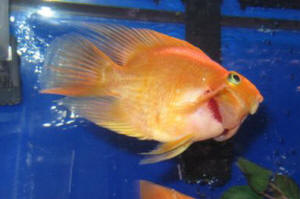 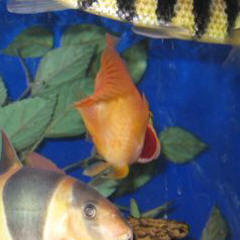
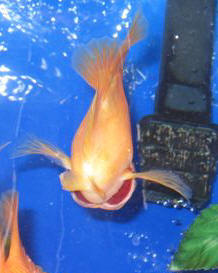 |
Upside Down Parrot Cichlid 7/7/05 I have 4 parrot fish in a
75 gallon tank. I have had the same fish for over 4 years with
virtually no problems. Recently, one of the fish has started hanging
upside down in the plants. He still can right himself, swims
around without difficulty, and eats well. Other than the
hanging upside down, there is nothing unusual. At first I
thought it was a swim bladder problem, or a problem from feeding at the
surface, but it has not corrected itself. The fish store
told me that if he was eating, not to worry. Any suggestions? Thanks
Brenda < If it is an internal bacterial problem then it needs to be
treated with Metronidazole. Other than that it could just be
intimidation from the other fish that has got him hiding.-Chuck>
|
Blood heart parrots, no useful info. 11/22/05
I have two of these beautiful blood "heart" parrot
fish, a green Severum, and an iridescent shark in a 55 gallon
tank. All of my water parameters look great, <Like the
"war" in Iraq? Non-informational.> but just today I
noticed that at the end of each top fin, on both the heart
parrots, there are grayish/black patches. I wondered if you could
tell me what this is and if I need to treat them, and if so, how?
<No way to tell from here, with this lack of info.> The
green Severum picks on them sometimes, but not much, could it be
some sort of bruising? Thanks for your time.......Melody.
<Umm, please read here: http://www.wetwebmedia.com/FWSubWebIndex/fwsubwebindex.htm
re Set-up, Cichlid Systems... Bob Fenner>
Re: blood heart parrots 11/24/05 Hi
Bob, Sorry about the previous lack of information. My
55 gallon tank has been up and running for about 3 months now.
When I started it up, I used Bio Spira and added about 100 feeder
Danios for 2 and a half months. I use a Penguin Bio-wheel, an
air-stone and an underwater heater. There are several
plastic plants and gravel. Ammonia is 0, Nitrates 0,
nitrites 0, ph about 7.8. I just added the green Severum
and the heart parrots about 2 weeks ago, and the iridescent shark
a few days ago. I feed them a combination of tetra flakes, frozen
brine shrimp, and Hikari cichlid pellets (extra small). The
grayish/black areas that I mentioned previously are on the top
fin towards the back on both of my heart parrots. One is about
the size of a pencil eraser, and on the other parrot the patch is
a little larger. Neither area has any raised spots, and the heart
parrots are eating just fine and acting normal. My question
was whether it could be some sort of bruising, or is it stress,
injury, or a natural occurrence? Thanks in advance for your
help......... Melody. <Thank you for the further information.
I suspect the black markings are "just natural" here...
not uncommon in this very hybridized cichlid cross. Not likely
pathogenic (caused by a biological disease agent), and I would do
nothing outright to try and "treat" them. Cheers, Bob
Fenner>
Re: blood heart parrots (III) - 11/24/2005 Thank you so
much! I was really worried, as I have formed an attachment to
these gorgeous creatures. I appreciate your rapid
response! -Melody. <Bob's out, so from me
(Sabrina) and the rest of the WWM Crew, thank you for your kind
words.>
|
| Parrot Cichlid With Throat/Mouth Problem -
01/12/2006 I am Desperate to save my 9" Parrot Fish. Few
chat forums have had any idea of diagnoses. I'm left unanswered
by others because of my "hybrid." Please help me save my
best friend. I'll describe then detail. The visible problem is
his mouth. The first week it just appeared 'swollen.' No
sign of fungus or Columnaris. Just what looked like a tumor growing
inside his lower lip, swelling the outer lip, and making it hard to
eat. He (even now) is Always hungry. A forum suggested a med so I
treated the first 4 days with Maracyn (along with water changes)
and it only got worse. By worse I mean, at the end of the first
week he only had a pinhole left in his mouth that food could get
through. Smaller lumps formed on top of the larger one. I
couldn't see any fuzziness. As you can see in the pics, there
is also a small red dot on the outside of his lip. They were a
little pink/reddish in color. (he is dark orange) His fins are
lightly frayed by his gills. The dorsal and tail are healthy. I had
posted his pictures on numerous forums and no one had a clue. My
local LFS gave me Furan-2 meds and SUCCESS! Along with half dosage
of Mela-fix and decreased temp to 75F he got better. For a full 5
days the lump went down, and he was able to eat efficiently but the
lump had not completely gone away. So last night (now two weeks
with mouth problem) I increased the temp back up to 78F but still
issued Furan-2 and Melafix as usual. I figured he was getting
better and didn't want to subject his tankmates to anymore cool
waters. He was fine this morning. I come home from work, and its
Worse Than Ever. Not only is his lumpy lump almost full size again,
but he has a red pimple in the middle of his lower lip that looks
like it could pop any second. He also has stringy hairs on the
outside and inside of his mouth. Coloration and rest of body look
fine. My water conditions as of today are; Nitrites 0, Nitrates
20ppm, ammonia 0, pH 6.8, water - a little hard, temp 78F (was
75F), The tank is 55 gal. - other tankmates 1:pictus cat, 1:pleco,
1:butterfly ram, 1:gourami, 1:babyparrotfish All the fish get fed a
variety of pellets, dried krill, vegetable flakes, and tropical
crisps. The photos are from before he grew the pimple and fuzzy
hairs. I have yet to photograph his new 'state'. Please let
me know if I'm leaving any info out and PLEASE... if you have
any idea... help me save my fish =(-Jessica < Sometimes fish try
to eat things that they are not good for them. I suspect that your
parrot cichlid has an obstruction in his throat. As he tries to
expel it , the movement of the obstruction has damaged the tissue
in the area and it got infected and swollen. You treated the
infection and the swelling went down. Now the fish tried to expel
it again and has started things all over again and is swollen,
maybe reinfected. remove the fish from the water with a wet towel
and try and look down the throat to see if there is an obstruction.
Usually it is a piece of plastic plant, a filter part or an odd
shaped piece of gravel. If you do not see anything then it could be
a broken pharyngeal bone. This is a second set of jaws that
cichlids use to chew their food. Sometimes this gets broken from
pellets that are too hard to chew. I would recommend that you
presoak the fish food to soften it up.-Chuck> |
|
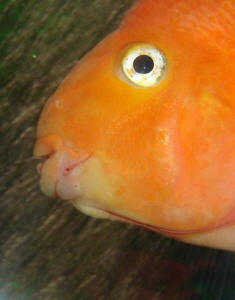

Parrot Cichlid Problem II 1/13/06 That you so
much for the quick response. I just wanted to add a quick update. The
night I wrote that entry, I stopped administering meds and decreased
the temp back down to 75F without my usual 2-day 15% water change. I
figured, the only thing I did different before he got worse was
increase the temp. And I'm tired of medicated my other healthy
fish. The very next day... Swelling went down and the red pimple is
gone! He still has a swollen lump and outer lip, but only about 40% of
the previous days size. I was shocked! Not that he's totally
better, but it gave me much more hope. Do you think the temp decrease
had anything to do with the infection (fuzziness/red pimple) he had?
< I think the temperature reduction has lowered the fishes activity
level and it hasn't worsened the condition by trying to eat.> I
also want to check his throat out but this is the largest fish I've
ever owned and I don't want to damage his slime coat, fins or
scales by mis-handling. I hear of many people handling cichlids when
things get stuck in their mouths. I just want to know the proper and
safest way to do it. You mentioned a wet towel. Any more tips to make
sure I handle him with care? < Take a shallow pan and fill it about
half full with aquarium water. Place a towel inside the pan to absorb
the aquarium water. Take the fish out of the aquarium and place him on
the wet towel. Wrap the fish in the wet towel with just his head
exposed. Now that the fish is in control you can gently pry the mouth
open to see if there is any problems.> One more thing. If it is
something like a broken pharyngeal bone, does this ever heal? Or will I
have to deal (which I would cuz I love him) with his lump and random
infections forever? Thanks a million. You guys/gals must save a lot of
fish. YOU'RE HEROS! < The bone may heal over time with a long
term feeding program of soft mush foods.-Chuck> I have a parrot
approx 5-6 inches in length - about 18 mths old Need More
Info 5/11/07 <Hi, Jeni/Pufferpunk here> I have a
parrot approx 5-6 inches in length - about 18 mths old <Freshwater,
marine or avian?> He started with bubble fuzz on
the body and has swollen red gills and sitting on the bottom not eating
and his mouth is not open much having trouble breathing. The
local pet store gave me tetracycline and it seems to be getting worse -
any ideas? <Please post water parameters: ammonia, nitrites,
nitrate, pH. What is your water change schedule (how often,
how much)? How large is the tank/fish? Any tank
mates? There is no way we can help you without this
info. Most problems are due to poor water
conditions. Healthy tank=healthy
fish. ~PP>
|
|
|

